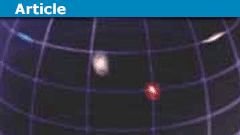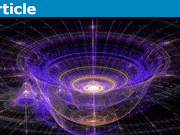Learn Inflation Balloon Analogy Misconceptions
This article was written with considerable input from several senior members of the PF community.
The Balloon Analogy is a simple-minded way to help describe (but not completely describe) two facts of cosmology that are difficult for many people to see, namely that the universe is expanding uniformly and that there is no center (and no edge).
The analogy is disliked (often intensely disliked) by serious physicists because it causes at least as much confusion as it is intended to avoid and is often badly misunderstood and/or incorrectly extrapolated to ridiculous points of view and this article is intended to help with that problem.
Presented here is the simple-minded balloon analogy and then a discussion of cosmology and why the balloon analogy is so flawed but also what it does help explain and how. There are many other aspects of cosmology that can get drawn into discussions of the balloon analogy, but I have for the most part resisted discussing any that are not immediately relevant to the analogy, lest I get carpal tunnel syndrome while having this article turn into a textbook on cosmology (which I am not qualified to write anyway).
Table of Contents
What the Balloon Analogy is intended to describe
(1) The universe is expanding OUTSIDE of systems that are gravitationally bound, or bound by other local forces (e.g. strong and weak forces). That is, things the size of a local cluster of galaxies and smaller (like the Milky Way, Earth, you, me, atoms, and so forth), do NOT expand.
(2) The expansion has no center and everything is moving away from everything else, with things farther from each other receding faster from each other than things closer together.
THE ANALOGY
Think of each gravitationally bound system as a penny, and glue a bunch of these pennies onto a balloon that is only slightly blown up.
Now we blow up the balloon more. ALL of the pennies move away from each other uniformly, and those that are farther away from each other move away from each other faster than those that are closer together. If you choose ANY penny on the surface, it sees ALL of the other pennies moving away from itself and it sees the ones farther away moving away faster than those close by. No penny is the center of the expansion. There IS no center to the universe.
That is the way the universe works and that is what the analogy is intended to show. The fact that all the pennies move away from each other and that ones farther away move away faster and that there is no center.
What DOESN’T work in using the balloon analogy and how it can be more usefully thought of
FIRST: NO CENTER there is no center. Only a portion of the surface of the balloon is to be considered in the analogy. This is difficult for some people to get their head around because it is so obvious that the balloon is really a 3D object with a center. Well, yes it is, BUT NOT IN THE ANALOGY. Only the surface counts in the analogy, so if you insist that there IS a center, you are completely misunderstanding and misusing, the analogy and you are likely arriving at one of those false conclusions that make physicists grit their teeth at the balloon analogy. So don’t! There is no center (to the balloon surface in the analogy or to the universe)
SECOND: SIZE/SHAPE The analogy should ONLY consider a portion of the balloon’s surface — it does not make any statements about the size or shape of the universe (other than it is getting bigger). Forget that the surface of the balloon is curved. That’s NOT intended to be representative of the actual universe. It is actually more reasonable to think of a flat sheet of rubber that is being stretched equally in all directions. That would be a better analogy, but you’d have to confine the analogy to only a section of the sheet. Edges would NOT be part of the analogy. The analogy is not intended to comment in any way on the shape of the universe, whether it is open or closed, flat or curved, or ANY of those things. Those are NOT part of the analogy. The universe not only has no center, it has no edge, but that does not imply that it is necessarily infinite, it could be finite but unbounded (like the surface of the Earth, for example). Also, the balloon, as we humans look at it and consider only the surface, is a 2D object (the surface is) but we recognize that it is embedded in a 3D world. The analogy is NOT intended to imply that our 3D universe is embedded in some 4D space (I’m not talking about 4D space-time but 4 dimensions of distance) — that just isn’t part of the analogy.
THIRD: LOCAL EFFECTS The pennies don’t change size (gravitationally bound systems don’t expand and nothing inside of them expands), they just get farther apart and none of them are at the center. There IS no center. The most reasonable way to UN-simplify the balloon analogy in this regard would be to consider that the construct is not a balloon with pennies glued to it but rather that it is a balloon in which, somewhat magically, pennies have been embedded such that the circumference of the pennies melds with the rubber and there IS no rubber inside the area of the pennies. When the balloon expands, the pennies get farther apart but THEY do not expand. Even this UN-simplification of the analogy has a problem because actually, dark energy does exist inside of gravitationally bound systems, it just doesn’t have any effect (see the comments at the bottom of the page).
FORTH: NO STRETCHING The surface of the balloon “stretches” and this leads to weird discussions of the “stretching” of space or the “expansion” of space. To further UN-simplify the balloon analogy, what you REALLY need to think of is the construct described in “THIRD” directly above, BUT … take away the actual balloon material and just think of things happening to the pennies as though the balloon WAS there (so as to maintain the pennies’ motion in the analogy). In other words, what cosmology REALLY says is not that space stretches or expands but rather just simply that gravitationally bound systems keep getting farther away from each other. It is DISTANCE that is changing, not space. This is another of those things that are badly served by the balloon analogy. There is of course, in some sense, “more” of something in between galactic clusters as the distance increases, but just what it is that there is “more” of gets to be a theological/philosophical discussion that gets WAY beyond the balloon analogy. I refer you to Metric Expansion of Space
FIFTH: COSMOLOGICAL TIME There are sometimes attempts to bring cosmological time into the analogy by considering that the 3D center of the balloon represents the singularity and the balloon (the universe) expanded from there. This is an excellent example of stretching the analogy WAY beyond where it is intended to go (pun intended).
EXPANSION(S)
There are really three “expansions” that people get mixed up about.
INFLATION — In a very early and very tiny fraction of a second, just after the singularity, the universe “expanded” in an incredibly massive burst. This is known as INFLATION, not expansion, although it IS an expansion as the term is used in the English language. This inflation is NOT a 100% confirmed fact, and there are differences of opinion about it among physicists (and cosmological models), but it is by far and away the best model to explain the universe as we understand it. This “inflation” was in some ways very similar to the current accelerated expansion, and there is some lively discussion in physics circles as to the possibility of a relationship between the two, but that’s getting a bit beyond the balloon analogy.
EXPANSION — After inflation, the universe settled down to a more sedate rate of expansion and THIS is what is normally meant by the EXPANSION of the universe. It is still going on today. This expansion has NOTHING to do with “dark energy” (see the paragraph directly below), although dark energy has been present, as far as is known, since the beginning of the universe AND has been having an effect all along although it did not overwhelm gravity until about 8 billion years after the singularity. There really have been two things going on all along, the expansion I’m talking about here, AND the contribution of “dark energy”, but see directly below for further discussion.
ACCELERATION of the expansion — Up until sometime in the late 1990s, it was assumed that gravity was slowing down the rate of expansion (as it was understood in the paragraph above, with no reference to “dark energy” and that eventually, it would either reach a steady-state and just go on at a constant rate forever, or much more likely would reverse direction and contract (the Big Crunch scenario). When the first possible measurements were made, much to everyone’s surprise, it was found that not only is the rate of expansion NOT slowing down, it is ACCELERATING. This acceleration is NOT what is normally meant by “expansion” (see the paragraph directly above), it is the ACCELERATION of the expansion. It is attributed to a force that is not understood, and that has been given the name “dark energy”. The “dark” just means we have no idea what it is (just what it does), and this is TOTALLY unrelated to “dark matter” (which is called “dark” because it is LITERALLY dark … it does not reflect or emit any electromagnetic radiation at any frequency, including visible light). So “dark energy” has been around all along, we now understand, and about 6 billion years ago, it started to overcome gravity and cause the expansion to start accelerating.
OTHER NOTES ON COSMOLOGY
Dark energy and dark matter have NOTHING to do with each other and all statements I have ever seen to the contrary have been utter nonsense. It would likely have saved hundreds of thousands of keystrokes here on The Physics Forum if “dark matter” had been more appropriately called “Zwicky matter” and “dark energy” had been called “vacuum energy”
“Dark energy” is so staggeringly weak on local scales (a planet for example) that it has an effect that is described by some as (various forms of the phrase …) “utterly negligible” and by others as “non-existent”. I’m in the “non-existent” camp and my favorite analogy is that it is like an ant pushing on a house. It’s not that the ant has such a tiny effect that it is not measurable, it is that the any has no effect at all. The ant IS pushing on the house, but it cannot to any extent at all overcome the forces that keep the house on its foundations.
Expansion, even with acceleration, is so staggeringly slow on small scales that it might as well not be happening. Over cosmological distances, it has a huge effect, but here’s my favorite analogy to show local effect. Even though the universe is expanding, it’s still going to be hard to find a parking place. This is just a simple-minded way of thinking about the local effects of the expansion. If you could go out into intergalactic space and magically draw a set of parking place lines, it would be about TWENTY BILLION YEARS before they had moved far enough apart to let you park a second car. Now, I’m willing to circle the block a couple of times to get a parking place, but twenty billion years is just too much. I’d be late for the movie.
On the other hand, it has such a huge effect over cosmological distances, that the galaxies at the edge of our observable universe are receding from us at something like 3 times the speed of light. No speeding tickets are issued, because they are not moving faster than light in our frame of reference, they are just getting farther away. It’s like a boat being carried down a fast river. To someone on the boat, it’s traveling 10 mph but to someone on the bank, it’s moving 25 mph. It’s the 10 mph that has to be compared to the speed limit; the 25mph is irrelevant to the speed limit.
NOTE: measures of distance and time in cosmology, as well as the shape/extent of the universe and the fact that “space” is really “space-time”, are all very complex topics, and my simplistic ways of talking about them in this article are just that … simplistic. My point here was to produce a fairly modest, but correct (with some simplifications) analysis of the balloon analogy without, as I noted at the beginning, writing a text on cosmology.
Also, my use of the pop-science terms “expansion/expanding” should not be interpreted to mean that space is a “thing” that can bend/stretch/expand. Things get farther apart (Metric Expansion) and things with no force applied to them move on “bent” (Euclidean) lines which are actually straight lines in the math that describes space-time (Riemann Geometry)
Studied EE and Comp Sci a LONG time ago, now interested in cosmology and QM to keep the old gray matter in motion.
Woodworking is my main hobby.








[QUOTE=”Jorrie, post: 5336963, member: 46478″]I’ve always been skeptical of the B&H argument, since it would imply that a string of COs could not all be at the same cosmological time. It may not be a sufficient argument, but to me it made SR redshift as an interpretation for cosmological redshift uncomfortable, to say the least.[/QUOTE]
Peacock and Chodorowski argue that interpreting the cosmological redshift one should take gravity into account. And I think this makes sense because in curved space-time the redshift isn’t purely dopplerian per se. But at the end, as we talk about interpretations the answer to this question is not wright or wrong but might be rather a matter of personal taste.
[URL]http://arxiv.org/abs/0809.4573[/URL]
[URL]http://arxiv.org/abs/0911.3536[/URL]
[QUOTE=”RUTA, post: 5336916, member: 181686″]But, O’s analysis refutes B&H’s argument using SR with small v = Hr between COs.[/QUOTE]
I’ve always been skeptical of the B&H argument, since it would imply that a string of COs could not all be at the same cosmological time. It may not be a sufficient argument, but to me it made SR redshift as an interpretation for cosmological redshift uncomfortable, to say the least.
Someone who wishes to remain anonymous sent me the following link: [URL]http://arxiv.org/abs/1111.6704[/URL]. In this paper, [URL=’http://arxiv.org/find/physics/1/au:+Ostvang_D/0/1/0/all/0/1′]Dag Østvan[/URL]g (O) shows that Bunn & Hogg’s (B&H’s) claim that a pair of co-moving observers (COs) who have small enough Hubble velocities (v = Hr) relative to each can be considered to occupy the same flat spacetime frame is false. O shows specifically that in the flat or closed RW models, it is not possible to have H nonzero if the curvature is zero. Thus, O concludes that the redshift caused by v = Hr is 100% attributable to spacetime curvature, so it is best understood as a “gravitational redshift” not a “kinematic redshift” as B&H claim. Further, one cannot use the SR Doppler formula between observers with very small v = Hr, since the SR Doppler formula can only be applied between observers who share the same flat frame and any nonzero v = Hr entails nonzero spacetime curvature. O does agree that the SR Doppler formula can be used on the parallel transported 4-velocity of the emitter at emission, which is the Nalikar-Synge computation. He also eschews the notion of “expanding space,” so I don’t think O would disagree with B&H’s conclusion that the redshift is a “Doppler shift” not an “expanding space shift.” But, O’s analysis refutes B&H’s argument using SR with small v = Hr between COs.
None of this causes me to change what I have my students compute as far as kinematics in RW cosmology (although I will definitely add this material to my GR course). I have them compute recession velocity of and proper distance to the source at time of reception and time of emission as a function of z in the Einstein-deSitter model. [itex]r = 3ct_o left(1 – frac{1}{sqrt{1 + z}}right)[/itex], [itex]v = 2c left(1 – frac{1}{sqrt{1 + z}}right)[/itex], [itex]v_e = v sqrt{1+z} [/itex], [itex]r_e = frac{r}{1+z}[/itex], and [itex]t_e = frac{t_o}{left(1+zright)^{1.5}}[/itex]. Then we add [itex]Lambda[/itex] and obtain [itex]dot{a} = H_o sqrt{frac{Omega _m}{a} + Omega _Lambda a^2}[/itex] with [itex]Omega _m + Omega _Lambda = 1[/itex] which I have them use to verify [itex]frac{t_e}{t_o} = 0.0366[/itex] for z = 9.6, [itex]Omega _m = 0.3[/itex] and [itex]Omega _Lambda = 0.7[/itex] found in [URL]http://arxiv.org/abs/1204.2305[/URL]. Then I have them obtain [itex]ddot{a} = 0[/itex] at z = 0.671 [itex]left(frac{t_e}{t_o} = 0.544 right)[/itex] with [itex]Omega _m = 0.3[/itex] for comparison with [URL]http://www.ptep-online.com/index_files/2012/PP-29-02.PDF[/URL].
I finally took the time to derive the cosmological redshift [itex]z+1 = frac{a_o}{a_e}[/itex] using the accumulated nonrelativistic redshifts along the path of the light, as in Eqs (4) & (5) of [URL]http://arxiv.org/pdf/0808.1081v2.pdf[/URL]. It’s straightforward and nicely shows how the local flat frames can be pieced together along the light path in the global curved spacetime. I also liked the authors’ derivation of their Eq (6) [itex] sqrt{frac{c + v_{rel}}{c – v_{rel}}} = frac{a_o}{a_e}[/itex] using the SR velocity addition equation in local flat frames along the light path, i.e., parallel transport. Very cool. I will add the contents of this paper to my GR course.
That being said, I don’t agree with their view that [itex]v_{rel}[/itex] constitutes a “natural” notion of velocity for cosmology. “… the velocity of the galaxy at the time of light emission relative to the observer at the present time” is about as unnatural as I can imagine haha. The natural notion is clearly v = Hr, i.e., proper time rate of change of proper distance, which holds not only locally, they use it to get both Eqs (5) and (6), but globally in the “expanding bread” or “stretching rubber sheet” analogies. That view is very Newtonian, so it’s very intuitive and as Rindler once told me, “It’s not just an analogy, it’s exact!” But, it is certainly the case that there is no unique way to define velocity between objects that don’t share a local flat frame in curved spacetime, so to each his own :-)
Thanks again for sharing that article, marcus. Hopefully, now that I’ve gone through the derivation myself, I won’t keep requiring you to post it :-)
That looks familiar, marcus. I think we’ve had this exchange before :-)
[QUOTE=”RUTA, post: 5317487, member: 181686″]Narlikar once told me you can derive the cosmological redshift using the Doppler shift between local frames, integrated from emission event to reception event. I’ve always meant to check that, but never got around to it …[/QUOTE]
[URL]http://arxiv.org/abs/0808.1081[/URL]
[SIZE=6][B]The kinematic origin of the cosmological redshift[/B][/SIZE]
[URL=’http://arxiv.org/find/physics/1/au:+Bunn_E/0/1/0/all/0/1′]Emory F. Bunn[/URL], [URL=’http://arxiv.org/find/physics/1/au:+Hogg_D/0/1/0/all/0/1′]David W. Hogg[/URL]
(Submitted on 7 Aug 2008 ([URL=’http://arxiv.org/abs/0808.1081v1′]v1[/URL]), last revised 14 Apr 2009 (this version, v2))
A common belief about big-bang cosmology is that the cosmological redshift cannot be properly viewed as a Doppler shift (that is, as evidence for a recession velocity), but must be viewed in terms of the stretching of space. We argue that, contrary to this view, the most natural interpretation of the redshift is as a Doppler shift, or rather as the accumulation of many infinitesimal Doppler shifts. The stretching-of-space interpretation obscures a central idea of relativity, namely that it is always valid to choose a coordinate system that is locally Minkowskian. We show that an observed frequency shift in any spacetime can be interpreted either as a kinematic (Doppler) shift or a gravitational shift by imagining a suitable family of observers along the photon’s path. In the context of the expanding universe the kinematic interpretation corresponds to a family of comoving observers and hence is more natural.
[QUOTE=”JDoolin, post: 5231675, member: 268035″]So is there a valid feature of the Balloon analogy that actually contradicts with Doppler recession?[/QUOTE]
Narlikar once told me you can derive the cosmological redshift using the Doppler shift between local frames, integrated from emission event to reception event. I’ve always meant to check that, but never got around to it …
[QUOTE=”PeterDonis, post: 5248553, member: 197831″]Not in the sense I have been using the term “acceleration”. You will notice that I have tried to say “proper acceleration”, to make it clear that I am talking about acceleration that is actually felt–or, in the case of the space station and the sun and distant galaxies, [I]not[/I] felt. All of those objects are in free fall, feeling zero acceleration.
I’m sorry I said sun, but meant Galaxy, the sun is in orbit affected by gravity. Could the solar winds of our galaxy be pushing other galaxies away from us?
The kind of “acceleration” you are referring to when you say that the sun is accelerating away from other stars is more precisely called “coordinate acceleration”. (Actually, the red shifts you are referring to are from other galaxies, not other stars; we can’t see individual stars at the distances at which the cosmological redshift becomes measurable. So it’s more correct to say that our galaxy as a whole sees other galaxies’ light as redshifted.) The key point about coordinate acceleration is that you can change it by changing coordinates–i.e., by a mathematical abstraction that doesn’t change anything physical. So if you are trying to understand the actual physics going on, coordinate acceleration is the wrong thing to focus on.
No, they don’t. Red shifts, in and of themselves, only tell us that the universe is expanding. They do not tell us that the expansion is accelerating. For that, we need not only the observation that there are red shifts, but detailed correlations between red shifts and other observations, like the brightness and angular size of distant galaxies.
Also, once again, when we say the universe’s expansion is “accelerating”, we mean this in the sense of coordinate acceleration, not proper acceleration. All of the galaxies have zero proper acceleration. See below.
You are confusing coordinate acceleration and proper acceleration here. The sun has zero proper acceleration, and that means there is no net force acting on the sun. The sun does have nonzero coordinate acceleration in certain coordinates, but coordinate acceleration does not tell you whether there is an unbalanced net force. Only proper acceleration does. As above, all of the galaxies have zero proper acceleration, so there is no unbalanced net force acting on any of them.[/QUOTE]
[QUOTE=”Edriven, post: 5248338, member: 572993″]the difference in the space station and the sun is that the space station is not accelerating away from the earth. Due to red shift we know that we are accelerating away from other stars. Right?[/QUOTE]
Not in the sense I have been using the term “acceleration”. You will notice that I have tried to say “proper acceleration”, to make it clear that I am talking about acceleration that is actually felt–or, in the case of the space station and the sun and distant galaxies, [I]not[/I] felt. All of those objects are in free fall, feeling zero acceleration.
The kind of “acceleration” you are referring to when you say that the sun is accelerating away from other stars is more precisely called “coordinate acceleration”. (Actually, the red shifts you are referring to are from other galaxies, not other stars; we can’t see individual stars at the distances at which the cosmological redshift becomes measurable. So it’s more correct to say that our galaxy as a whole sees other galaxies’ light as redshifted.) The key point about coordinate acceleration is that you can change it by changing coordinates–i.e., by a mathematical abstraction that doesn’t change anything physical. So if you are trying to understand the actual physics going on, coordinate acceleration is the wrong thing to focus on.
[QUOTE=”Edriven, post: 5248424, member: 572993″]red shift tells us that the universe is accelerating.[/QUOTE]
No, they don’t. Red shifts, in and of themselves, only tell us that the universe is expanding. They do not tell us that the expansion is accelerating. For that, we need not only the observation that there are red shifts, but detailed correlations between red shifts and other observations, like the brightness and angular size of distant galaxies.
Also, once again, when we say the universe’s expansion is “accelerating”, we mean this in the sense of coordinate acceleration, not proper acceleration. All of the galaxies have zero proper acceleration. See below.
[QUOTE=”Edriven, post: 5248424, member: 572993″]Therefore the sun can not be in a balanced free fall because it is accelerating.[/QUOTE]
You are confusing coordinate acceleration and proper acceleration here. The sun has zero proper acceleration, and that means there is no net force acting on the sun. The sun does have nonzero coordinate acceleration in certain coordinates, but coordinate acceleration does not tell you whether there is an unbalanced net force. Only proper acceleration does. As above, all of the galaxies have zero proper acceleration, so there is no unbalanced net force acting on any of them.
[QUOTE=”Edriven, post: 5248453, member: 572993″][URL]http://news.nationalgeographic.com/news/2011/10/111004-nobel-prize-physics-universe-expansion-what-is-dark-energy-science/[/URL]
I’m sorry I might have confused you with my red shift comparison. Nonetheless the universe is expanding. Which means unequal force and acceleration[/QUOTE]
No, it does not. Yes, the universe is expanding, and at an accelerating rate, but what “unequal force” are you talking about? The sun in not accelerating in the sense that you think it is, nor are the distant galaxies that are receding from us at an accelerating rate.
[QUOTE=”Edriven, post: 5248449, member: 572993″][/QUOTE]
[QUOTE=”Edriven, post: 5248449, member: 572993″][/QUOTE]
[URL]http://news.nationalgeographic.com/news/2011/10/111004-nobel-prize-physics-universe-expansion-what-is-dark-energy-science/[/URL]
I’m sorry I might have confused you with my red shift comparison. Nonetheless the universe is expanding. Which means unequal force and acceleration
[QUOTE=”phinds, post: 5248433, member: 310841″]Ah, good. Now I understand your question.
No, red shift does NOT tell us that the sun is accelerating. You are making a very common mistake of confusing recession velocity with proper velocity. Google “Metric Expansion” for more discussion.[/QUOTE[/QUOTE]